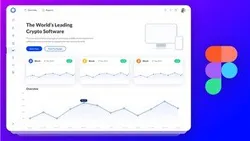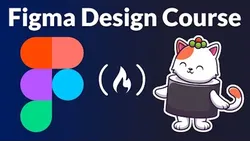
Learn UI&UX Design & Figma - 2022 Interactive Crash Course 
This course provides an interactive crash course in UI/UX Design and Figma. Students will learn how to choose a background, add a layout grid, design a logo, create components, and navigate the Figma UI. They will also be challenged to complete the uEye Challenge and create their own project. ▼
ADVERTISEMENT
Course Feature
![]() Cost:
Cost:
Free
![]() Provider:
Provider:
Youtube
![]() Certificate:
Certificate:
Paid Certification
![]() Language:
Language:
English
![]() Start Date:
Start Date:
On-Demand
Course Overview
❗The content presented here is sourced directly from Youtube platform. For comprehensive course details, including enrollment information, simply click on the 'Go to class' link on our website.
Updated in [February 21st, 2023]
This course provides an interactive crash course in UI&UX Design and Figma. Students will learn the basics of UI/UX design and how to use Figma to create interactive designs. The course will cover topics such as project preview, choosing a background, adding a layout grid, designing a quick logo, creating components, creating navigation, designing the hero section, adding a layer blur, adding features, call to action, 3 column design, features prototyping, call to action prototyping, adding a Lottie animation, prototyping the overlay, and prototyping a sub page. At the end of the course, students will have a better understanding of UI&UX Design and Figma and will be able to create interactive designs.
[Applications]
After taking this course, participants can apply their knowledge of UI&UX design and Figma to create interactive designs for websites, apps, and other digital products. They can use the skills they have learned to create a logo, navigation, hero section, layer blur, features, call to action, 3 column design, and more. Additionally, they can use the prototyping techniques they have learned to create a sub page and overlay. Finally, they can use the Lottie animation to add a dynamic element to their design.
[Career Paths]
1. UI/UX Designer: UI/UX Designers are responsible for creating user-friendly interfaces and experiences for websites, apps, and other digital products. They use a combination of research, design, and coding to create products that are both visually appealing and easy to use. As technology continues to evolve, UI/UX Designers will need to stay up to date on the latest trends and techniques to ensure their products remain competitive.
2. Product Designer: Product Designers are responsible for creating the overall look and feel of a product. They use a combination of research, design, and coding to create products that are both visually appealing and functional. As technology continues to evolve, Product Designers will need to stay up to date on the latest trends and techniques to ensure their products remain competitive.
3. Interaction Designer: Interaction Designers are responsible for creating user-friendly interfaces and experiences for websites, apps, and other digital products. They use a combination of research, design, and coding to create products that are both visually appealing and easy to use. As technology continues to evolve, Interaction Designers will need to stay up to date on the latest trends and techniques to ensure their products remain competitive.
4. Visual Designer: Visual Designers are responsible for creating visually appealing designs for websites, apps, and other digital products. They use a combination of research, design, and coding to create products that are both aesthetically pleasing and functional. As technology continues to evolve, Visual Designers will need to stay up to date on the latest trends and techniques to ensure their products remain competitive.
[Education Paths]
1. Bachelor of Science in Computer Science: This degree path focuses on the fundamentals of computer science, such as programming, software engineering, and computer architecture. It also covers topics such as artificial intelligence, machine learning, and data science. This degree is becoming increasingly popular as technology continues to evolve and become more integrated into our lives.
2. Bachelor of Science in Human-Computer Interaction: This degree path focuses on the design and development of user interfaces and experiences. It covers topics such as user research, usability testing, and user experience design. This degree is becoming increasingly popular as companies strive to create better user experiences for their customers.
3. Master of Science in Human-Computer Interaction: This degree path focuses on the advanced topics of user interface and experience design. It covers topics such as user experience research, user interface design, and user experience evaluation. This degree is becoming increasingly popular as companies strive to create better user experiences for their customers.
4. Master of Science in Interaction Design: This degree path focuses on the design and development of interactive systems. It covers topics such as user interface design, user experience design, and interactive system design. This degree is becoming increasingly popular as companies strive to create better user experiences for their customers.
Course Provider

Provider Youtube's Stats at AZClass
Discussion and Reviews
0.0 (Based on 0 reviews)
Explore Similar Online Courses

Ecommerce With WooCommerce

Learn CCNA 200-301 Routing and Routing Protocols

Python for Informatics: Exploring Information

Social Network Analysis

Introduction to Systematic Review and Meta-Analysis

The Analytics Edge

DCO042 - Python For Informatics

Causal Diagrams: Draw Your Assumptions Before Your Conclusions

Whole genome sequencing of bacterial genomes - tools and applications

From idea to MVP without coding Intro to Figma & Bravo

Learn How to Design a Website in Figma


Start your review of Learn UI&UX Design & Figma - 2022 Interactive Crash Course